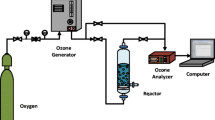Abstract
Study was carried out for the removal of hazardous organic compound from aqueous solution by using water/perfluorodecalin loaded ozone two-phase system. p-Chloronitrobenzene was used as hazardous organics to examine the efficiency of the two-phase ozonation system. Effects of initial pH in water, stirring speed, initial molar ratio of O3/p-chloronitrobenzene (M), and free radical scavenger on the removal rate of p-chloronitrobenzene were investigated respectively. It was revealed that ozone had low decomposed rate coefficient k = 0.0035 min−1 and solubility of 61.94 mg/L at 25°C in perfluorocarbon. In contrast to pH 2.0, higher level of pH (8.0) in water increased the removal rate of p-chloronitrobenzene in water/perfluorocarbon two-phase ozonation system. Removal rate of p-chloronitrobenzene was increased with the elevation of initial M value in water/perfluorocarbon two-phase ozonation system. Stirring speed was needed to control with proper level of speed in water/perfluorocarbon two-phase system. Compared to the conventional gas/water ozonation system, NaHCO3 (20 mmol/L) had no obvious negative effect on the p-chloronitrobenzene degradation in water/perfluorocarbon ozonation system. Oxidation efficiency of ozonation in water/perfluorocarbon system was superior to that of in conventional gas/water system.










Similar content being viewed by others
References
Anthony LG, Tanza LL, Stacy AW, Sergey AN (2008) Stoichiometry of ozonation of environmentally relevant olefins in saturated hydrocarbon solvents. Environ Sci Technol 42:3582–3587
APHA (1998) Standard methods for the examination of water and wastewater, 20th edn. United Book Press, Baltimore, Maryland
Bhattacharyya D, van Dierdonck TF, West SD, Freshour AR (1995) Two-phase ozonation of chlorinated organics. J Hazard Mater 41:73–93
Bin AK (2006) Ozone solubility in liquids. Ozone Sci Eng 28:67–75
Camel V, Bermond A (1998) The use of ozone and associated oxidation processes in drinking water treatment. Water Res 32:3208–3222
Chang C, Chen J (1995) Application of a fluorinated solvent to the conventional ozonation process for the destruction of 2, 4-dichlorophenol. Environ Int 21:305–312
Gromadzka K, Nawrocki J (2006) Degradation of diclofenac and clofibric acid using ozone-loaded perfluorinated solvent. Ozone Sci Eng 28:85–94
Gromadzka K, Wietlik JS (2007) Organic micropollutants degradation in ozone-loaded system with perfluorinated solvent. Water Res 41:2572–2580
Kim WH, Nisijima W, Baes AU, Shoto E, Okada M (1997a) Pilot plant study on ozonation and biological activated carbon process for drinkingwater treatment. Water Sci Technol 35:21–28
Kim WH, Nisijima W, Baes AU, Okada M (1997b) Micropollutant removal with saturated biological activated carbon(-BAC) in ozonation-BAC process. Water Sci Technol 36:283–298
Milena GM, Daniele MB, Márcia D (2008) Degradation and estrogenic activity removal of 17β-estradiol and 17α-ethinylestradiol by ozonation and O3/H2O2. Sci Total Environ 407:105–115
Pera-Titus M, Garcia-Molina V, Banos MA, Gimenez J, Esplugas S (2004) Degradation of chlorophenols by means of advanced oxidation processes: a general review. Appl Catal B Environ 47:219–256
Reungoat J, Macova M, Escher BI, Carswell S, Mueller JF, Keller J (2010) Removal of micropollutants and reduction of biological activity in a full scale reclamation plant using ozonation and activated carbon filtration. Water Res 44:625–637
Rivas FJ, Beltran FJ, Acedo B, Garcia Araya JF, Carbajo M (2005) Kinetics of the ozone-p-chlorobenzoic acid reaction. Ozone Sci Eng 27:3–9
Rosenfeldt EJ, Linden KG (2007) The R-OH, R-UV concept to characterize and the model UV/H2O2 process in natural waters. Environ Sci Technol 41:2548–2553
Walker GM, Kasem KF, O’Toole SJ, Watt A, Skeoch CH, Davis CF (2003) Early perfluorodecalin lung distension in infants with congenital diaphragmatic hernia. J Pediatr Surg 38:17–20
Ward DB, Tizaoui C, Slater MJ (2003) Ozone-loaded solvents for use in water treatment. Ozone Sci Eng 25:485–495
Acknowledgments
This work was supported by the Major Project of the National Water Pollution Control (2008ZX07101-003-004), Key Laboratory of Integrated Regulation and Resource development on Shallow Lakes Open Fund of Hohai University (408127), Priority Academic Program Development of Jiangsu Higher Education Institutions.
Author information
Authors and Affiliations
Corresponding author
Rights and permissions
About this article
Cite this article
Li, S., Zhu, Y., Li, X. et al. Degradation p-Chloronitrobenzene in Ozone-loaded System with Perfluorodecalin Solvent. Bull Environ Contam Toxicol 87, 297–302 (2011). https://doi.org/10.1007/s00128-011-0352-6
Received:
Accepted:
Published:
Issue Date:
DOI: https://doi.org/10.1007/s00128-011-0352-6




